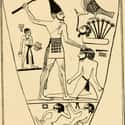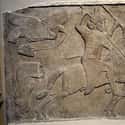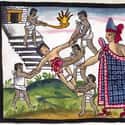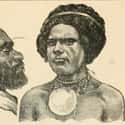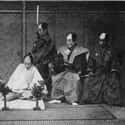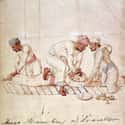-
(#1) Burned Alive, Bludgeoned, And Hanged: The British
The ancient British left no written historical records of their own, so much of what we know about ancient Britain is based on Roman writings. Julius Caesar wrote that Druids built massive wicker men, loaded them with human and animal sacrifices, and lit them on fire. Others suggest this is Roman hyperbole designed to make the British appear savage.
Whether or not human sacrifices actually happened in wicker effigies, evidence exists of human sacrifice in ancient Britain. Bodies found in bogs show evidence of ritualistic slaying, possibly undertaken as offerings to the gods.
-
(#2) Dismembered: The Chinese
One of the most powerful empires in Chinese history, the Shang Dynasty lasted for more than 500 years, and is the first recorded period in ancient Chinese history. It was also home to brutal techniques focused on ripping apart the bodies of those who were sacrificed.
Shang human sacrifice victims were burned, split into halves, beheaded, or chopped up. The most common ceremonies were pit, foundation, and interment sacrifices. For pit sacrifices, young men were ripped apart and buried without their possessions. Foundation sacrifices involved children and infants, while interment sacrifices focused on young women.
Some of the people sacrificed were captives, others criminals. The Shang also made sacrifices to various gods.
-
(#3) Hung Upside Down And Beaten: The Hawaiians
Early Tahitian invaders of Hawaii practiced a number of human sacrifice techniques, victimizing descendants of the Polynesians who initially settled the Hawaiian Islands. Those sacrificed were mostly captives, though some were tribe members who broke laws or committed taboo acts.
Sacrifice techniques included strangulation, bone-breaking, and the complete removal of the intestines. Early Hawaiians practiced human sacrifice to appease Ku, the god of war and defense, in order to ensure victory in future battles. Captives from enemy tribes, especially chiefs, were sacrificed in sacred temples through a variety of means, including being hung upside down, bludgeoned, and bled. They were then disemboweled and the remaining flesh, either cooked or raw, was eaten by the priest and the chief of the tribe.
-
(#4) Buried Alive: The Ancient Egyptians
In the golden age of ancient Egypt, pharaohs were buried with effigies of their retainers (servants and other followers), but pharaohs of the First Dynasty were buried with their actual, living retainers, in a practice known as retainer sacrifice.
These servants (and sometimes high-ranking officials) were sacrificed in accordance with religious beliefs. According to these beliefs, servants were meant to continue serving their rulers after they perished. Essentially, rulers were so important that they needed an entourage in the afterlife.
As the First Dynasty ended, retainers managed to convince pharaohs that they could better serve if left alive to continue carrying out the will of the pharaoh on Earth.
-
(#5) Fatal Blow To The Head: The Mesopotamians
Like the pharaohs of ancient Egypt, the royals of ancient Mesopotamia were buried with the rest of their household. This included some members of the royal court, such as soldiers, handmaidens, and servants. Human remains found at an archaeological site in Ur (now Iraq) attest to more than 2,000 people being sacrificed in this way.
In an innocent near-past, experts believed victims of sacrifices in Mesopotamia were poisoned peacefully before burial. Recent discoveries suggest a more brutal practice. Analysis of skeletal remains suggests that victims were struck in the head before burial. Some have speculated that targets may have been struck in the head to end them because the poison wasn't enough, thus preventing them from being buried alive. However, the truth about why they were dispatched in such a way remains unknown.
-
(#6) Removal Of The Heart: The Aztecs
Many probably think first of the Aztecs when they hear "ritualistic human sacrifice," and with good reason. Human sacrifice was widespread in Aztec culture, and sacrificial techniques were ruthless. The Aztec worshipped a pantheon of gods that they believed they had to appease through blood sacrifice - both animal and human. Archaeologists estimate that a few thousand people were sacrificially slain each year for this purpose. While some came from the Aztec community, many were prisoners of war.
During sacrificial rituals to the sun god, the victim was forced to walk up the many steps of a temple; at the top, a priest cut the person open from throat to stomach. The heart was then removed and offered to the god. The person was then pushed from the top of the temple down the stairs to the bottom, where they were dismembered or taken away.
-
(#7) Strangled Widows: The Fijians
In ancient Fiji, the traditions of some indigenous groups required that a widow be strangled shortly after her husband's passing. This ritual was carried out because Fijians believed all women should accompany their husbands in the afterlife. These widows were referred to as the "carpeting of his grave." It was common in most tribes for the widow's brother to strangle her, or at least oversee the act.
Australian anthropologist Lorimer Fison reportedly overheard the following between a sister and a brother while studying the tribes in question:
"O Matakimbau," [the wife] cried, "Malani is dead! Take pity upon me and strangle me to-day."
"All right," her brother replied. "Go now and bathe yourself, and put on your ornaments. You shall be strangled by-and-by."
-
(#8) Mass Decapitation Of Slaves: The Dahomey
Xwetanu was an annual celebration in Dahomey, an ancient West African kingdom located in present-day Ghana. The ceremony consisted of many things, including the sacrifice of slaves to honor deceased kings. The preferred method of sacrifice was decapitation.
So many sacrificial victims were beheaded that the ceremony's name translates to "yearly head business." One source states that thousands of people were sacrificed under the leadership of one king.
-
(#9) Tossed Into Pits: The Mayans
The Mayans were a highly religious people known for hosting elaborate ceremonies. One of these ceremonies included the seemingly brutal practice of throwing human sacrifices into large limestone pits called cenotes, which typically had water at the bottom.
These huge, natural sinkholes were believed to be portals to the spiritual realm. Therefore, people were pushed into them as divine sacrifices.
-
(#10) Honor Suicides: The Japanese
The Japanese practiced an honorary form of self-sacrifice called seppuku. Often referred to as hara-kiri in the West, the Japanese typically refer to it as seppuku. This practice was one of the many ritualized aspects of the life of samurai in feudal Japan. Samurai committed seppuku for a variety of reasons - as punishment for a crime, to restore their honor, or to show solidarity with a recently deceased lord.
The ritual had several steps. First, the warrior ate his favorite meal, dressed in his best robes, drank sake, and wrote, then recited, a death poem. Next, he thrust a dagger into the left side of his own abdomen (believed to release his spirit), drew the blade laterally to the right, and then turned the blade upward.
The end of the ceremony required an assistant, called a kaishakunin, to finish the sacrifice by decapitating the samurai.
-
(#11) Strangled With Handkerchiefs: The Thugs (Or Thuggee)
Over the course of hundreds of years, ending in 1830, an organized crew of dangerous outlaws known as Thugs, or Thuggee, brutally sacrificed more than 30,000 people throughout India. Considered a cult of religious assassins by some, the superstitious Thugs found targets by following natural phenomena they believed to be omens. They ended their targets in a variety of ways, including strangling them with handkerchiefs. The sacrifices were meant to honor Kali, the goddess of creation, preservation, and destruction.
Thugs would disguise themselves as travelers, merchants, or soldiers to gain the trust of their targets. Despite its bloody activities, the cult had a strict code of ethics. According to one source, they were prohibited from sacrificing "fakirs, musicians, dancers, sweepers, oil vendors, carpenters, blacksmiths, maimed or leprous persons, Ganges water-carriers, and women." However, they would sometimes slay women if it was necessary to maintain the cult's secrecy.
New Random Displays Display All By Ranking
About This Tool
Human sacrifice is one of the ten most terrifying customs in the world. The ancients believed that everything was controlled by God. Therefore, people pray for the blessings of the gods through rituals and usually donate valuable things as tribute, and even live humans were as tributes to show piety in some places. For example, in Maya culture, there is a tradition of killing human beings as sacrifices, and the Maya's method of killing sacrifices is bloody and violent.
There were many types of sacrificial rituals in ancient society, and their ways changed according to time and region. Among the many sacrificial rituals, the cruelest is human sacrifice. The random tool introduced 11 details about different human sacrifice practices.
Our data comes from Ranker, If you want to participate in the ranking of items displayed on this page, please click here.














